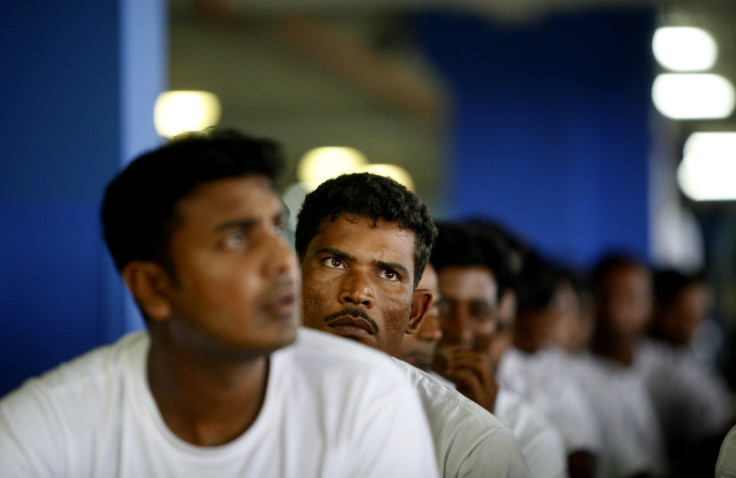Low Pay, But Steady Work: Malaysia Opens Doors Again To Bangladeshi Migrant Laborers

The Malaysian government has approved the importation of new guest workers from Bangladesh after a nearly six-year moratorium.
The Daily Star newspaper of Bangladesh reported in January that Dhaka’s Expatriates' Welfare and Overseas Employment Ministry received an initial request from Kuala Lumpur for 10,000 migrant workers as soon as this month, due primarily to labor shortages at Malaysian palm oil plantations.
Malaysian Plantation, Industries and Commodities Minister Bernard Dompok told reporters: “Ultimately, we need about 40,000 of them.”
According to Bangladesh media, more than 45,000 job-seekers have already registered online for jobs in Malaysia.
On the whole, Malaysian authorities expect to recruit a half-million foreign workers over the next five years in the manufacturing, service, agriculture and construction sectors.
The New Straits Times reported that about 400,000 Bangladeshis are already employed in Malaysia’s manufacturing, construction, plantation and service industries.
In 2007, Malaysian authorities imposed an indefinite ban on new Bangladeshi workers in the wake of reports of chronic abuse and exploitation both by Bangladeshi recruitment agencies and Malaysian employers. In 2009, the Malaysians canceled some 55,000 visas for Bangladeshi laborers due to rising unemployment.
According to Aparupa Bhattacherjee of the India-based think tank Institute for Peace and Conflict Studies, under terms of the new Bangladesh-Malaysia labor deal, plantation workers will be recruited first for contracts of up to five years.
More importantly, to avoid the misbehavior and corruption of unscrupulous "recruitment agencies," middlemen will be eliminated from the hiring process entirely. The United Nations estimates that up to 150 Bangladeshis journey to Malaysia every week after paying exorbitant sums to traffickers who operate on illegal sea routes.
Bhattacherjee thinks the new agreement between the two countries should reduce illegal migration and ease the abuse suffered by Bangladeshi migrants.
“The agreement will put a stop to the harassment and exploitation of Bangladeshi immigrants working in Malaysia,” she wrote.
“It is a low-cost affair allowing many such people from poor households and backward regions to avail the opportunity to work in Malaysia’s labor market. … [It is also] a blessing for the Bangladeshi government, as the country is heavily dependent on remittances by expatriate Bangladeshis.”
Indeed, remittances from overseas migrants account the second-biggest foreign exchange earnings for Bangladesh, after the garment sector.
The Daily Times reported that some 8.5 million Bangladeshis currently working in foreign countries sent an aggregate of $12.85 billion home during the last fiscal year ended June, an all-time record, representing about 12 percent of the country’s GDP.
However, in recent years, some of the most popular destinations for Bangladeshi migrants -- Saudi Arabia and the United Arab Emirates, as well as Malaysia -- either placed severe restrictions on Bangladeshi workers or stopped accepting them entirely.
With Malaysia opening the doors a bit, the Bangladesh government hopes they will permit a larger flow of migrants.
“Malaysia boasts of a newly industrialized market economy, which is growing rapidly,” Bhattacherjee wrote.
“Due to rapid development, most educated Malaysians are shifting towards service sectors that promise a better standard of living. As a result, there is greater demand for foreign workers to fill gaps in the labor-intense markets of palm oil, construction, domestic help, and other such sectors that Malaysians are generally not involved in.”
In the past, Malaysian authorities have blamed Bangladeshi immigrants for criminal activity, applying for student visas without any intention of attending classes, and – most intriguingly – of creating “social disorder” in conservative Islamic Malaysia by trying to “seduce” the local women.
In early 2006, media in South and East Asia were ablaze with salacious reports of Malaysian women succumbing to the charms of “handsome” young Bangladeshi Lotharios who they thought resembled Bollywood film stars.
Reportedly, many of these young Casanovas arrived in Malaysia on student visas and took advantage of the local women in a relatively wealthy nation.
Radzi Sheikh Ahmad, then the Malaysian home affairs minister, told the Associated Press that the aggressive young Bangladeshi men pursued young women and even eloped with married women, who were taken in by their good looks
Abdul Malek Hanafiah, the chairman of something called the Islamic Affairs and Education Committee, was quoted as saying: "Under certain circumstances, we cannot just blame the foreigners because many local women, especially Malay women, are easily attracted to, and end up marrying men from Pakistan, India and Bangladesh because they apparently look like Bollywood stars."
Irene Fernandez, the head of Tenaganita, condemned such comments at the time.
“[We are] shocked and disturbed over the racist, chauvinist and patronizing statement of the home minister [Radzi],” she said.
“How can you use the good looks of people as a reason for blaming and for freezing the recruitment? Has the Malaysian government forgotten that we are recruiting not just workers but human persons who have social needs too? These policies are unjust and inhuman.”
But Bangladeshi men in Malaysia also apparently pursued female migrant workers from other nations as well as local women.
A Filipina named Umalla told local media: "I will ignore [the Bangladeshi men] when they flirt with me… If you talk to them, they will think you like them. There are a lot of Bangladeshi men. Some of them are handsome and neat. But I don't like it when they disturb me."
© Copyright IBTimes 2025. All rights reserved.




















